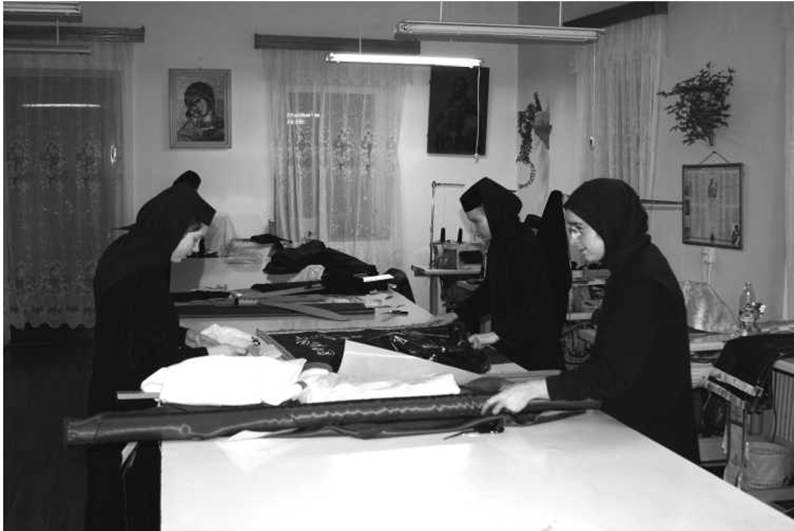Vestments
TENNY THOMAS
Sacred garments (vestimenta – Latin for “clothing”) of the clergy worn for liturgical celebrations, and some also worn outside the church. The dress of Orthodox clergy is now held to symbolize the vestments of the Aaronic priesthood (see Exod. 28.2–43; 39.1–31), but it originated in the styles of ordinary costume of the Greco-Roman upper classes in the ancient Christian world. While a better form of dress was probably used at sacred functions during the earliest centuries, the development of specific clerical costume occurred between the 4th and 9th centuries, the church retaining antique dress in liturgy long after everyone else. Outside the celebration of liturgical service, Orthodox clergy usually wear a black under-cassock (rason) under a larger outer-cassock (exorason, like an enveloping overcoat with ample bell sleeves). The specifically liturgical vestments are different for each order of clergy. The deacon wears a sticharion (white robe) with separate brocade cuffs (epimanikia) and a diagonally worn orarion (stole) on top. The latter can also be worn (girded in a cross shape over the body) by subdeacons, and even by tonsured altar servers in the Greek tradition. The priest wears the epimanikia, the sticharion, and a stole falling vertically from the neck in the form of the epitrachelion. He belts the sticharion and epitrachelion with the zone, and on top of all else wears the sleeveless enveloping outer-garment known as the phelonion. Bishops and senior priests may also wear a hypogonation (a diamond-shaped stiff embroidery suspended on the right side, a remnant of what was once a purse). In the liturgy the bishop wears over all the priestly vestments (except the phelonion) the distinctive garment of the sakkos, a T-shaped brocade garment that once signified high rank in the imperial court. On the seams are sewn bells to remind the worshippers of the robes of the High Priest in the Temple (Exod. 28.33). On top of the sakkos he wears a distinctive episcopal stole called the omophorion (a wide cloth band draped about the shoulders). All priests of the Russian tradition also wear a silver (sometimes gold) cross over the phelonion or cassock. Greek and other Orthodox clergy only wear the pectoral cross (usually a jeweled or enameled cross) if they have been awarded this as a mark of special honor. The jeweled cross is also reserved for very senior priests in the Slavic Orthodox tradition. The bishop wears, in and out of church, a jeweled medallion or panagia over the chest of his cassock, normally featuring an icon of the Virgin Mary. Archbishops and metropolitans are denoted by a second engolpion (meaning “that which is worn on the breast”) featuring Christ, or a jeweled pectoral cross alongside the panagia. In the liturgy the bishop also wears the mitre which is modeled on the ancient Byzantine imperial crown. In some Slavic traditions the mitre can be awarded as a sign of honor to an archpriest or higumen. The bishop’s mitre is surmounted by a cross, while a mitred- archpriest’s is not. A bishop will also carry a pastoral staff, usually T-shaped, symbolizing authority to govern. From early medieval times a code of vestment colors was developed to reflect the liturgical seasons: gold or white for normal Sundays, green for feasts of the Spirit, red for the Lord’s festivals, purple for Holy Week, and white for Pascha.

Plate 77 A convent workshop in Romania. The monastics support themselves from their own labors. Photo by John McGuckin
SEE ALSO: Divine Liturgy, Orthodox; Episcopacy; Epitrachelion; Phelonion; Sticharion
REFERENCES AND SUGGESTED READINGS
Chrysostomos, A. (1981) Byzantine Liturgical Dress. Brookline, MA: Holy Cross Orthodox Press.
Cope, J. (1986) “Vestments,” in J. G. Davies (ed.) A New Dictionary of Liturgy and Worship. London: SCM Canterbury Press.
McGuckin, J. A. (2004) “Vestments,” in The Westminster Handbook to Patristics Theology. London: Westminster/John Knox Press.
Mayo, J. (1984) A History of Ecclesiastical Dress.
New York: Holmes and Meier.
Pavan, V. (1992) “Liturgical Vestments,” in A. Di Berardino (ed.) Encyclopedia of the Early Church, vol. 2. Cambridge: James Clarke.
Pocknee, C. E. (1960) Liturgical Vesture: Its Origins and Development. London: A. R. Mowbray
